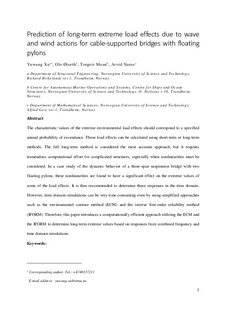| dc.contributor.author | Xu, Yuwang | |
| dc.contributor.author | Øiseth, Ole | |
| dc.contributor.author | Moan, Torgeir | |
| dc.contributor.author | Næss, Arvid | |
| dc.date.accessioned | 2019-02-25T09:39:24Z | |
| dc.date.available | 2019-02-25T09:39:24Z | |
| dc.date.created | 2019-01-07T08:53:05Z | |
| dc.date.issued | 2018 | |
| dc.identifier.citation | Engineering structures. 2018, 172 321-333. | nb_NO |
| dc.identifier.issn | 0141-0296 | |
| dc.identifier.uri | http://hdl.handle.net/11250/2587163 | |
| dc.description.abstract | The characteristic values of the extreme environmental load effects should correspond to a specified annual probability of exceedance. These load effects can be calculated using short-term or long-term methods. The full long-term method is considered the most accurate approach, but it requires tremendous computational effort for complicated structures, especially when nonlinearities must be considered. In a case study of the dynamic behavior of a three-span suspension bridge with two floating pylons, these nonlinearities are found to have a significant effect on the extreme values of some of the load effects. It is thus recommended to determine these responses in the time domain. However, time-domain simulations can be very time consuming even by using simplified approaches such as the environmental contour method (ECM) and the inverse first-order reliability method (IFORM). Therefore, this paper introduces a computationally efficient approach utilizing the ECM and the IFORM to determine long-term extreme values based on responses from combined frequency- and time-domain simulations. | nb_NO |
| dc.language.iso | eng | nb_NO |
| dc.publisher | Elsevier | nb_NO |
| dc.rights | Attribution-NonCommercial-NoDerivatives 4.0 Internasjonal | * |
| dc.rights.uri | http://creativecommons.org/licenses/by-nc-nd/4.0/deed.no | * |
| dc.title | Prediction of long-term extreme load effects due to wave and wind actions for cable-supported bridges with floating pylons | nb_NO |
| dc.type | Journal article | nb_NO |
| dc.type | Peer reviewed | nb_NO |
| dc.description.version | acceptedVersion | nb_NO |
| dc.source.pagenumber | 321-333 | nb_NO |
| dc.source.volume | 172 | nb_NO |
| dc.source.journal | Engineering structures | nb_NO |
| dc.identifier.doi | 10.1016/j.engstruct.2018.06.023 | |
| dc.identifier.cristin | 1651175 | |
| dc.description.localcode | © 2018. This is the authors’ accepted and refereed manuscript to the article. Locked until 1.10.2020 due to copyright restrictions. This manuscript version is made available under the CC-BY-NC-ND 4.0 license http://creativecommons.org/licenses/by-nc-nd/4.0/ | nb_NO |
| cristin.unitcode | 194,64,45,0 | |
| cristin.unitcode | 194,64,20,0 | |
| cristin.unitcode | 194,63,15,0 | |
| cristin.unitname | Institutt for konstruksjonsteknikk | |
| cristin.unitname | Institutt for marin teknikk | |
| cristin.unitname | Institutt for matematiske fag | |
| cristin.ispublished | true | |
| cristin.fulltext | preprint | |
| cristin.qualitycode | 2 | |

